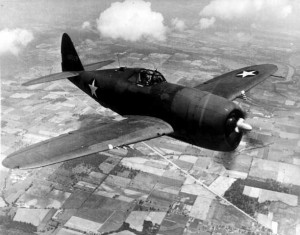10 Mar Fighter Escorts
When Herman and his crew arrived at Thurleigh in November 1943, the losses of the B-17 bomber crews had been very high. In effect, his crew was more than likely a “replacement crew” for one that had been lost. When ready to go overseas, the heavy bomber crews were sent wherever they were needed. That’s why they didn’t know until last minute where they were going.

Republic P-47D Thunderbolt, nicknamed “Jug,” During WW II, the P-47 served in almost every active war theater and in the forces of several Allied nations.
I have made an excellent contact through the forum at ArmyAirForces.com. Rowdy served in the Navy during the Vietnam War. His late father was a World War II navigator who flew 50 missions on 2 tours. He flew his 30th mission on D-Day. One of his Dad’s prized possessions was a “Lucky Bastard Club” certificate, an unofficial award given at some of the 8th Air Force bases to the B-17 airmen who had completed their tours.
As Rowdy explained … In May 1943, the army required airmen to fly 25 missions before they could go home. The combat tour requirement was raised from 25 to 30 missions by April 1944, then to 35 sometime in late Spring or early Summer 1944. The requirements were raised first in recognition that there were more bomber crews and groups coming on line by late 1943, and raised a second time in recognition that the introduction of long range fighter escorts by about February 1944 had remarkably improved the crews’ chances of survival.
The long-range fighter escorts that Herman refers to in his diary were the P 38’s, P 47’s, and P 51’s. These were welcome competition for the German fighter planes.
- The P-38 Lightning. German pilots nicknamed this plane “The Forked-Tail Devil.” In September of 1943, it was the only fighter with range enough to accompany the B-17 bombers into Germany.
- The P-47 Thunderbolt. A single engine fighter plane, one of the larger ones.
- The P-51 Mustang. Long range single seat fighter that came on the scene in 1944. Herman mentioned a “P-51” that February. The Mustang was able to fly deeper into Germany.
When the mission requirement was 25, there simply wasn’t much chance that a crew would survive their tour. The high attrition rates of those early 1942-43 missions mathematically told the story. Overall, the average bomber crew in the Eighth completed only 15 missions during WWII.
THANKS, Rowdy. We’re the “lucky ones” … our Dads came home.


Rowdy
Posted at 22:55h, 26 AprilHi Pat,
I changed my photo account so your link to my LB collage is now a dead link. Here is a new address for it:
http://i675.photobucket.com/albums/vv114/j1c2a3s/Air%20Corps%20Perm/SmallCollage.jpg
Spent some time going through your blog tonight…great job.
Rowdy
Pat
Posted at 10:23h, 27 AprilThanks, Rowdy! I have changed the link. Appreciate your kind words. I’m into the tough stuff now … it’s all amazing to me, each segment of it.
William Patrick Maher Jr.
Posted at 07:07h, 21 AprilSpeaking of fighter escorts… I just read this book:
Mad Rebel… A Youth at War by John Houston Oliphint
ISBN-10: 0966929403
How did I hear of it? John Houston Oliphint is our minister’s uncle. During a sermon recently, he was talking about his uncle’s WWII service; classified KIA then MIA then, after incredible hardships, returning to England.
I got the book through Interlibrary Loan. It’s ‘self-published’ but copies are available direct from the author (yes, he’s still alive), libraries, etc.
It’s a tough, harsh read … but the bluntness and lack of professional editing really adds to the impact, once I got used to the style.